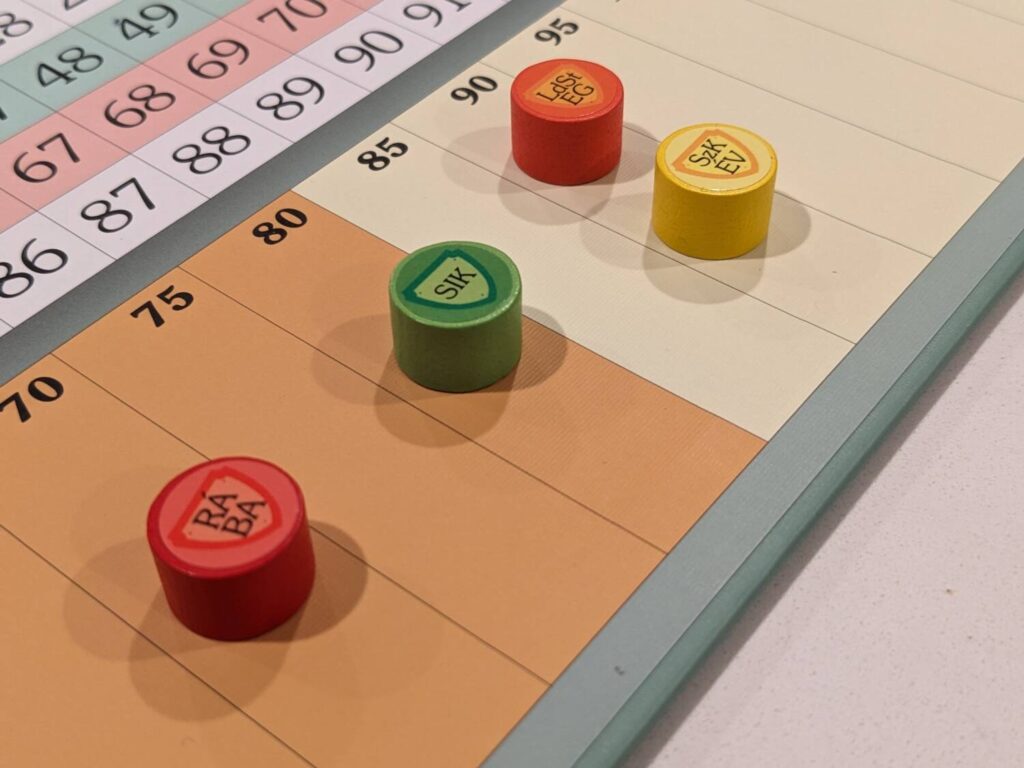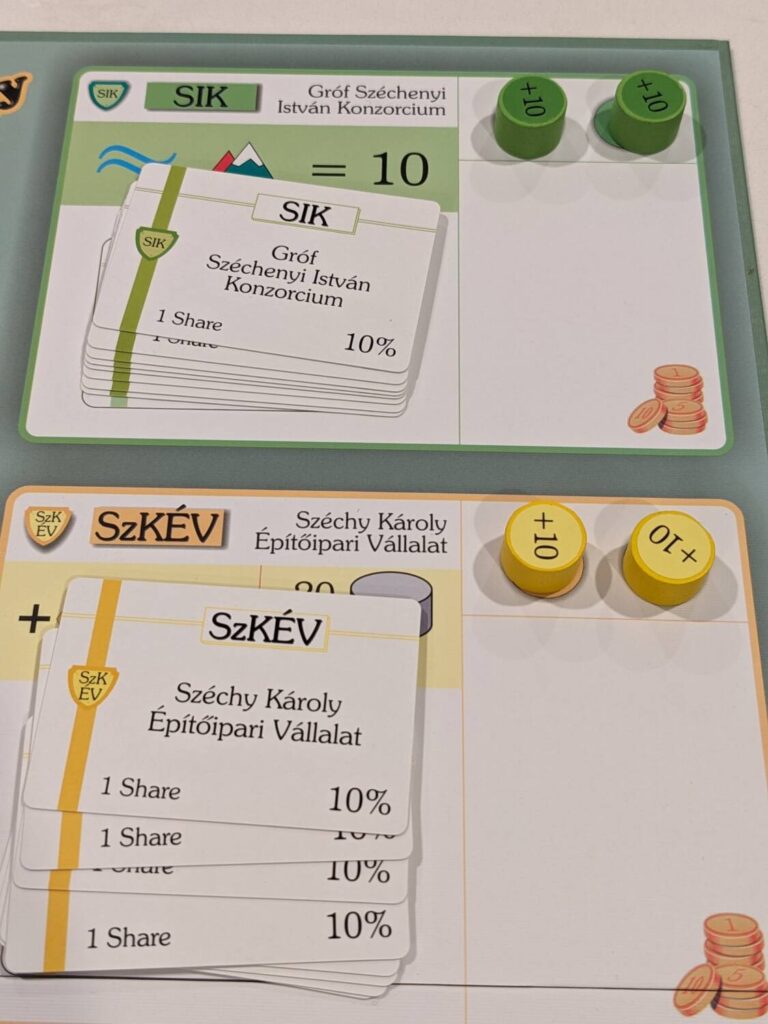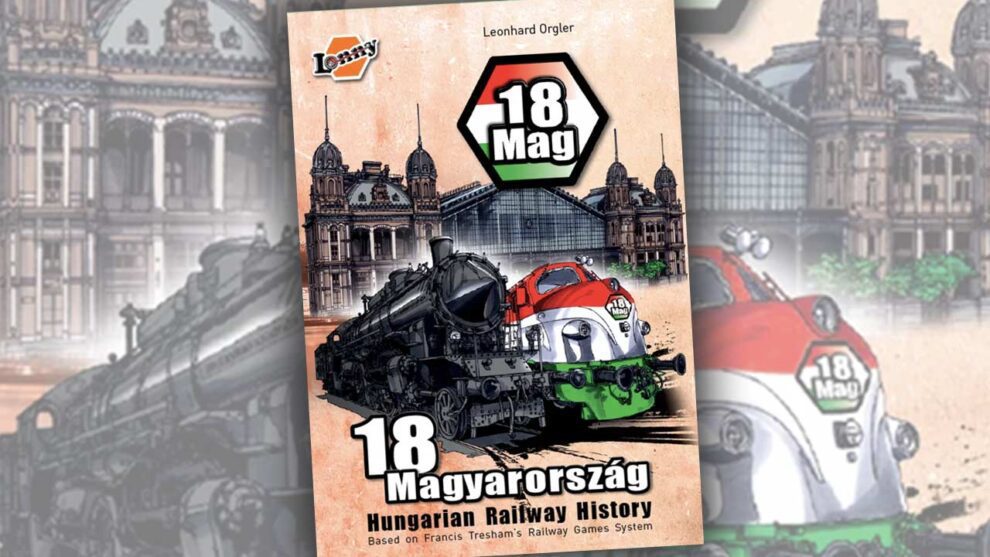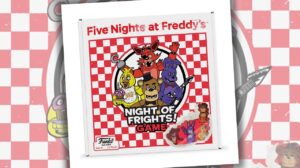Disclosure: Meeple Mountain received a free copy of this product in exchange for an honest, unbiased review. This review is not intended to be an endorsement.
My 18xx journey continues!
During my visit to SPIEL last fall, I spent a few minutes with Leonhard “Lonny” Orgler, the owner of publisher Lonny Games and the designer of train game classics such as 1880: China, 1848: Australia, and Russian Railroads. During that conversation, Lonny was kind enough to furnish a copy of 18Mag: Hungarian Railway History for review.
I’m seven plays into my 18Mag journey, and I will give it this much: this is the most unique of the 18xx titles I’ve tried so far thanks to a couple major changes to the system. I don’t think all these changes work, but for those who are looking to shake things up a bit, 18Mag delivers a satisfying experience. Also, this is the only 18xx game I own that has a solo mode!

Minors, Not a Setback
18Mag is a 1-6 player economic tile-laying game based on the 18xx system created by Francis Tresham that began with the game 1829, released more than 40 years ago. For more details on how games in the 18xx system typically play, please read my kickoff article, 18xx: A Beginner’s Journey. There’s also a growing pool of content on the 18xx format that walks a new player through the steps of how to play these games.
18Mag is set in Hungary where the first Hungarian railway, MAV, kicked off operations in 1846. Players take on the roles of entrepreneurs trying to end the game with the most cash (as usual), but in 18Mag players are only going to run minor companies with a two-train limit.
That alone was enough to get me curious about playing this game. Minors in other games are usually the stepping stones for mergers, or they serve as independent railroads that are later absorbed by major corporations. In 18Mag, they are the only businesses that will run routes for the entire game, and they are drafted during the game’s setup. (Players begin 18Mag with zero cash—the monetary unit is forints in 18Mag—which represents another substantial change from other 18xx titles.)
Here’s what else is drafted during setup: major corporation shares. The same seven majors (eight when playing with the expansion content for 18Mag) are used in every game, and each major grows in a fun way—when players do different things that help them make more money for their minors.

For example, Ganz & Cie (G&C) makes a little money each time a player wants to run routes through towns in addition to cities. Gróf Széchenyi István Konsorcium (SIK) makes 10 forints for every difficult terrain symbol in a hex. Lokomotivfabrik der Staatseisenbahn-Gesellschaft (LdStEG) earns half of every train purchase payment into its treasury.
That means stock rounds in 18Mag are a bit unique. No one can invest in minors, only majors. Majors’ share values are randomly assigned to begin the game, then major shares are bought in 10% increments, with a president being named once a player holds at least 20% of a company as usual. But the president only makes one real decision each round—how much in dividends should be paid out. Using a sliding scale for payments, shares can move up by as many as four steps if the president decides to pay out 21 forints or more in dividends.
So, the system here is a wild twist on the 18xx games I’ve tried previously. Thankfully, operating minors is pretty vanilla in a very operationally focused game. You lay or upgrade one piece of track, and can do more things if you want to spend the money, which benefits one of the seven majors. Trains don’t rust in 18Mag, so while each minor starts with a 2-train, they can add another 2-train later, and discard trains at will while moving through 2-, 3-, 4- and 6-trains in later rounds. The game phases still trigger the end game and the tile types available, so when a player buys the first 6-train, that unlocks gray tiles and begins to trigger the end game.

It’s All About the Mindset
18Mag is a game I initially struggled to understand because so many of its facets are unique to the 18xx world.
That starts with the game’s map. Every turn, in every game, I had to remind myself of my priorities based on which companies I had shares in. I also took the advice of one of my opponents during my first 18Mag game on 18xx.games: focus on the income of the minors early on, so that you can be ready to buy a bunch of shares while they are cheap to ride them up.
Another big change: much of your final score (in-game income) comes from your minors, and not your major company shareholding. That means you want to find routes that could make you 500, 600, even 700 forints in a single stage of an operating round. Players split revenues 50/50 with their minors, so a 600-forint run nets 300 forints for the player. In 18Mag, it’s still great to have shares that spike in share value and make their way up the market. But cash is a big deal here and I’m used to playing 18xx games where a 3D stock grid is the main way to boost wealth.
Seven games in, I still haven’t won, another unique trait across the games I’ve tried. (I’ve won every other 18xx game I have tried at least three times.) This doesn’t make a game good or bad, but it is worth noting that a change in mindset is required to really understand the ways to win in a game like this one. In reading up a bit about 18Mag online, I have to agree with one element of what makes the game unique: it doesn’t really feel like an 18xx game. In fact, it’s more like a Euro, with centralized companies that I can invest in and manipulate without having full ownership.
These Euro elements really spike with the addition of expansion content, which Orgler was also kind enough to provide. There are once-per-operating-round player powers in the mix, which help a player lean even harder into investing in a specific major. The expansion content certainly gives the game legs for anyone looking to get lots of plays in, but in general the expansion content is not necessary.

Not Bad, But Certainly Different
Let’s agree on this much: Lonny Orgler doesn’t like to make the same (train) game twice.
18Mag does so many unique things that I’m having a hard time recommending it as an 18xx game. I’m used to slight tweaks on an established formula, with differences coming in terms of privates, the map, capitalization rules, and edge case differences. 18Mag blows a lot of things up and asks the player to adapt, with mixed results.
The main highlights of 18Mag: solo play; an interesting map that is better at lower player counts (3-4 players, ideally); and the ability to play a game that is as long or as slow as players would generally like, thanks to the lack of train rusting.
The stumbling blocks are unique—there are few investment options (and a lower certificate limit than in other 18xx games), with some of those options clearly better than others. Downtime in a six-player game can be massive, and some of the “wow” moments that arrive when the train rush begins simply don’t exist here thanks to the ruleset.
This is the first time I can claim an Orgler title to only be good, not an all-timer like my #3 game from 2023, 1880: China (co-designed by Orgler and Helmut Ohley). 18Mag is worth a look, and you can try it for free on the stellar 18xx.games to see if it is a fit for you and your game groups.











Add Comment